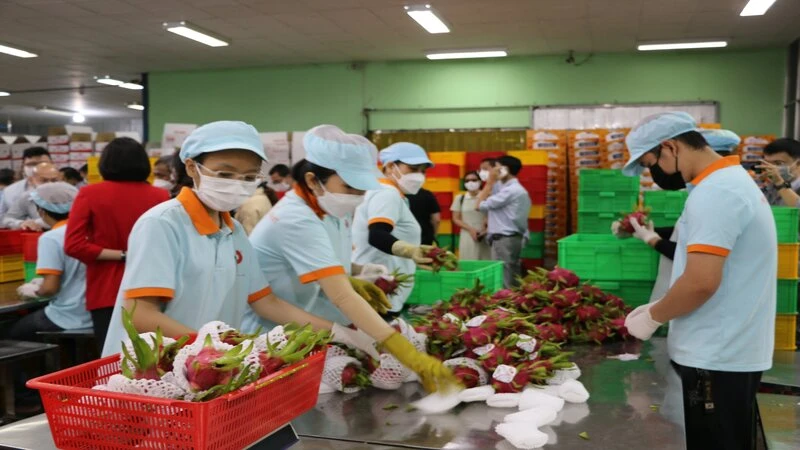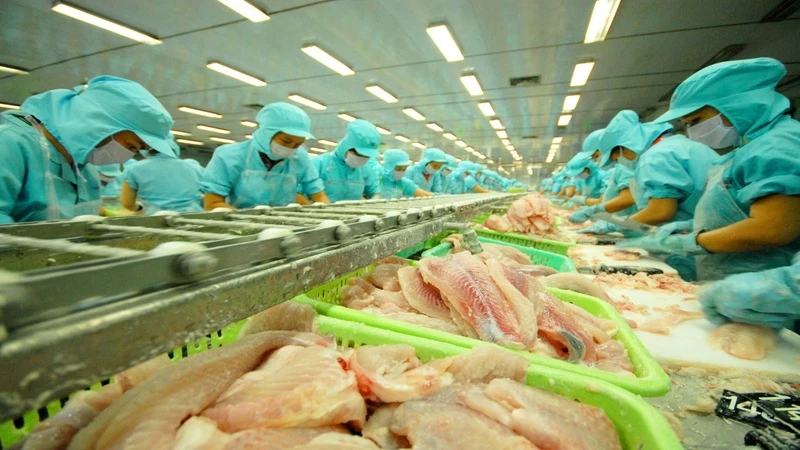 |
| Customers choose foods at Co.opmart Thanh Ha supermarket in Phan Rang-Thap Cham city, Ninh Thuan province. - Illustrative image (Photo: VNA) |
In June, Korean food maker Daesang spent 30 billion KRW (over 21.7 million USD) on expanding its plant in Vietnam, aiming to double its annual production capacity. Currently, Daesang has four factories in Vietnam, specialising in producing convenience foods, ready-to-eat foods and sauces, maltose and tapioca starch, and processing fresh meat. Last year, the firm earned 201.6 billion KRW in revenue in Vietnam, a twofold rise from the figure five years ago.
In April, Paldo Corporation completed the construction of its second factory near the southern province of Tay Ninh. This demonstrated its plan to establish a production belt spanning from the North to the South of the country. In the future, the company plans to further expand the facilities of its second factory to increase the production of instant noodles and use it as a base for exporting to neighbouring countries. In 2023, the revenue of its subsidiary Paldo Vietnam reached 79.7 billion KRW, up 17.4% year-on-year.
Vietnam is also chosen by Ottogi as an establishment to promote its global business operations and expand its business. Currently, Ottogi owns two factories in Bac Ninh and Binh Duong provinces. Recently, Ottogi introduced the "Oppa Ramen" product specifically for the Vietnamese market.
 |
| Many Vietnamese cultural products appeared at supermarkets in the RoK. (Photo: thoibaonganhang.vn) |
Among other well-known brands of the RoK in Vietnam, Orion stands out with sales reaching 500 billion KRW. In 2023, Orion Vietnam reported a total revenue of 475.5 billion KRW, surging by 62.8% compared to 2020. Thanks to its continuous growth in Vietnam, the enterprise is expanding its investment, including constructing more factories.
CJ CheilJedang is developing its fresh food business, focusing on frozen food, in Vietnam. It invested 30 billion KRW to establish an integrated production facility in the Mekong Delta province of Long An in 2022, and the firm plans to invest 100 billion KRW in its additional facilities next year.
After declaring its "globalization of soju" initiative in 2016, Hite Jinro aims to achieve 500 billion KRW in revenue from soju sales in foreign markets. The company has chosen Vietnam as its first overseas production base and decided to establish a manufacturing plant in the Green i-Park Industrial Complex in the northern province of Thai Binh. Hite Jinro's factory in Vietnam is scheduled to be completed by 2026, targeting 1 million products per year. This facility is expected to be expanded in the future and serve as a hub for the Southeast Asian market.
Insiders attributed the Korean food industry’s attention to the Vietnamese market to the Southeast Asian nation’s young population structure, which holds great consumption potential.
Vietnam is said to be a market where the Korean food sector has successfully penetrated and established strong recognition. Recently, the popularity of K-pop and K-culture has also boosted the popularity of K-food. To keep pace with this trend, Korean enterprises are increasing their investments in Vietnam, including expanding their facilities.
Vietnamese fruits and vegetables see opportunities to export to Germany
Vietnam is the 18th largest non-bloc vegetable, tuber and fruit supplier to Germany in the first three months of 2024, worth about 9.5 million USD, a year-on-year increase of 16.1%, according to the Ministry of Industry and Trade’s Import-Export Department.
 |
| Vietnamese fruit and vegetables have many prospects for export to the German market. (Photo: NDO) |
Meanwhile, according to statistics from the European Statistics Agency (Eurostat), in the first three months, Germany’s fruit and vegetable imports from markets outside the bloc reached about 1.1 billion USD, a year-on-year rise 5.1%.
Currently, Germany is not a large agricultural export market for Vietnam, but it boasts many prospects, especially when Vietnam has advantages from the Vietnam-EU Free Trade Agreement (EVFTA).
Among European countries, Germany is one of the largest markets for imported agricultural products due to its developed economy and diversity of consumer tastes.
Preliminary processing of pineapple for export at Dong Giao Food Export Joint Stock Company in the northern province of Ninh Binh province. (Photo: NDO)
Fruits such as bananas, oranges, apples and grapes are very popular. Germany also imports large amounts of vegetables such as tomatoes, cucumbers and peppers. In particular, the demand for organic fruits and vegetables is increasing strongly in the market.
However, Germany is one of the markets with many strict regulations in Europe, therefore, aiming to promote exports as well as increase market share of vegetables, tubers and fruits into Germany, Vietnamese export enterprises need to meet specific requirements for each type of product.
In addition, enterprises should plan to participate in international fairs to promote products and find partners because Germany is a venue for very large and effective international fairs.
Vietnam increases cinnamon imports from Indonesia, China
Vietnam imported 443 tons of cinnamon in May with a turnover of 1 million USD, an increase of 18.8% in volume from the previous month, according to statistics from the Vietnam Pepper Association (VPA).
Asia is Vietnam’s largest cinnamon import market, of which Indonesia and China are the two main cinnamon suppliers, with 308 tons and 96 tons, respectively.
 |
| Photo for illustration. (Source: congthuong.vn) |
In the first five months of the year, Vietnam imported 2,452 tons of cinnamon with a turnover of 5.7 million USD, down 75.2% in volume and 77.3% in turnover from the same period last year. Notably, China has risen to become the main supplier to Vietnam with 45.8%.
Meanwhile, Vietnam exported 33,528 tons of cinnamon with a total turnover of more than 96 million USD, down 1.1% in volume and 4.4% in turnover from the same period last year.
In Vietnam, cinnamon is distributed in almost all regions of the country. There are four concentrated cinnamon growing areas: Yen Bai, Quang Ninh, Thanh Hoa - Nghe An and Quang Nam - Quang Ngai.
Vietnam’s cinnamon bark reserves are estimated at about 900,000 – 1.2 million tons, with the average harvest yield of 70,000 - 80,000 tons a year. Vietnam is also the biggest cinnamon exporter in the world with a turnover of over 292 million USD by 2022.
According to the Vietnam Pepper and Spice Association, cinnamon is grown mainly in Vietnam, China, Indonesia and Sri Lanka. Cinnamon growing is currently a livelihood for hundreds of thousands of ethnic minority households in remote areas, and contributes to the socio-economic development of many localities.
Pangasius exports grow thanks to advantages from FTAs
Free trade agreements (FTAs) are considered an important step for the seafood industry, including pangasius, to “take off”, according to the Vietnam Association of Seafood Exporters and Producers (VASEP).
 |
| Vietnam’s pangasius exports grew strongly thanks to free trade agreements. (Photo: NDO) |
Thanks to making good use of the Comprehensive and Progressive Agreement for Trans-Pacific Partnership (CPTPP), in the first half of June 2024, Vietnam's pangasius export turnover to this market bloc reached 12 million USD, a year-on-year rise of 23%.
As of June 15, 2024, pangasius exports to the CPTPP market reached 114 million USD, a year-on-year increase of 10%.
Of which, Mexico imported the most Vietnamese pangasius with a value of 31 million USD, up 7%; Japan 18 million USD, up 35%; Canada 18 million USD, up 15% and Singapore 16 million USD, up 0.2% year on year.
In the last six months of 2024, pangasius exports to the CPTPP bloc are expected to continue to surge as prices and demand are gradually stabilizing.
Businesses need to improve their competitiveness and study the benefits from this agreement in terms of tariffs to seize opportunities and increase exports.
Besides the CPTPP market, frozen pangasius fillets are also the main product of Vietnam exported to the European Union (EU) with advantages from the Vietnam-EU Free Trade Agreement (EVFTA).
In the first five months, the EU bought 67 million USD worth of frozen pangasius fillets from Vietnam, accounting for 11% of the total value of the commodity.
The Netherlands imported the most Vietnamese pangasius in the bloc, worth nearly 2 million USD in the first half of June 2024, up 3% year on year. As of June 15, 2024, pangasius exports to the Netherlands posted nearly 21 million USD, down 9% year on year.
In addition to the Netherlands, some other markets recorded positive growth in Vietnamese pangasius imports as of June 15, 2024, such as Germany 17 million USD, 0.3%; Spain 9 million USD, up 27% and Belgium 8 million USD, up 10%./.